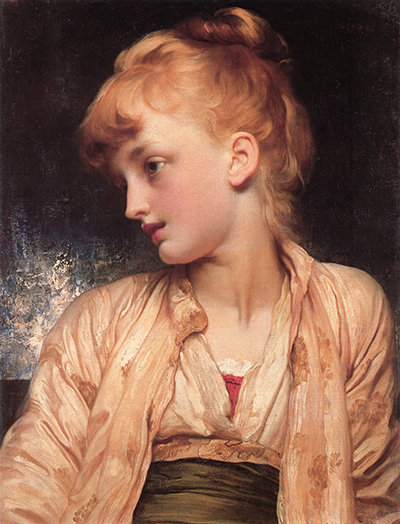Gulnihal is an oil-on-canvas painting, painted by the distinguished 19th-century artist, Sir Frederick Leighton. It the portrait of a girl of tender years.
She's rather young-looking, although she could be a teenager. She's on the brink of life and seems to be somewhat vulnerable. It's quite a close-up portrait, so the artist was able to view the subject at close range. The only information available to this writer on the subject of the portrait is her name. Gulnihal seems to be a Turkish name. Apparently, it's quite a common name in Germany. There's a Turkish population there, so this could be how the name occurs. The young girl is fair-skinned and golden-haired, almost red-headed.
Her eyes are a blue-grey colour. She's sitting in a relaxed position as if she's just been running about or playing a strenuous game for a while. Or maybe she's just sleepy, depending on the time of day. She's sitting in a relaxed, casual manner. Her clothes appear to be eastern, reminiscent of the type of outfits traditionally worn by young Pakistani or Indian girls. The cloth appears to be gold, tissue-type silk. Although she is young, she appears to have the potential to become a beauty in adult life. She has fair skin, full, red lips, a sharp nose and attractive eyes. It seems that she's from a westernised family of Turkish or middle-eastern extraction. They had to be wealthy to be able to commission a portrait in the 19th century.
Sir Frederic Leighton was born in Scarborough in Yorkshire in 1830 into a distinguished family. He died in London in 1896. He was associated with the pre-Raphaelite movement in the 19th century. He was educated at the University College, London and he studied art in Europe. He was a painter, sculptor and illustrator. He was President of the Royal Academy from 1878 to 1896. He was honoured for his work, by being awarded both a knighthood and a peerage, which expired with him. He died without heirs, being a lifelong bachelor. Leighton gained prestige when his first major work was purchased by Queen Victoria. That was Cimabue's Celebrated Madonna is Carried in Procession through the Streets of Florence, painted in 1855. It's still in the British Royal art collection.
Leighton was influenced by the 17th-century Italian and French master painters. His work was popular with the public and he's considered to be one of the finest English painters of his time. His paintings sold as prints throughout the country. He was also considered a major sculptor. Classical art was a huge influence on this artist. This probably accounts for a large amount of Greek and Roman subjects in his artworks. His style was considered to be neoclassical. His legacy lives on through his large body of work.




